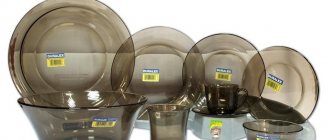The twist-off screw cap is a real godsend for canning: they allow you to roll up food without a special key machine. But many housewives ask, is it possible to reuse screw caps? First of all, it depends on the quality and strength of the tin. It is important that the integrity of the thread and the coating inside is not compromised. For this purpose, the products are carefully inspected. And if everything is in order, use it for seaming again.
Pros and cons of twist-off caps
Screw-on lids are the most popular option for canning among modern housewives.
Advantages of twist-off lids:
- unlike a regular seaming cap, a twist-off is somewhat denser;
- available for reusable use;
- provided that all requirements are met, conservation costs a very long time;
- Twist-offs are extremely convenient to use, since a rolling machine is not required.
There are also disadvantages:
- in comparison with other types, the cost of twist-off caps is slightly higher;
- Opening a jar with such a lid is quite difficult. Physical strength may be required.
Tin cans
Dear friends and visitors to our store www.samogon-plus.ru , pay attention to the section “Tin cans for canning”. This is a convenient, practical and modern packaging for food products. The offered tin containers are manufactured on high-precision equipment from food-grade tin with a thickness of 0.18-0.22 mm in accordance with the requirements of GOST and ISO (international quality standard). The varnish-enamel coating of the can ensures safe preservation of any type of food product.
Is sterilization required?
Screw-on twist-off lids are successfully used for preserving vegetable salads, pickled vegetables, and jam. Proper sterilization will help ensure a long shelf life for products.
Only intact lids without chips or dents are suitable for sterilization. If the inside is varnished, special attention should be paid to the integrity of the coating. Before sterilizing twist offs (especially new ones), they are washed using liquid dish soap and rinsed thoroughly with running water.
Sterilization methods:
- Boiling is a popular and simplest method. Bring water to a boil in a small saucepan, lower the lids and boil for at least fifteen minutes.
After boiling, they must be taken out and this must be done correctly. Do not put your hands in the water under any circumstances. Firstly, there is a high probability of getting burns, and secondly, the sterilization procedure becomes useless.
Correctly remove the lids with tongs (clean, sterilized). While hot, the lids are immediately placed on the filled jars and, covered with a clean towel, screwed on by hand.
- Steam sterilization. Boil water in a saucepan. While the water is boiling, place a colander on the container, into which we place the twist-off with the inside down. To enhance the steam effect, the colander can be covered. After fifteen minutes, remove the pan from the heat and use the twist off for its intended purpose.
- Sterilization in the oven. This is a fairly convenient method, as it allows you to sterilize the lids (they are laid out with the inside up) and jars at the same time. The oven is heated to 50 C, after ten minutes the temperature is increased to 100 C. Sterilization time is fifteen minutes.
You need to preheat the oven gradually, as a sudden temperature change may cause the sealing jar to burst. And one more very important rule: never sterilize jars with screw caps in the microwave.
In the oven
Boiling
Ferry
Warming up in the oven
This method is convenient because you can sterilize both twist-offs and jars together.
Heat the oven to +50°. Place screw caps and glass jars in it. After 10 minutes, increase the temperature to +100° and sterilize the products for another 15 minutes.
Be sure to increase the temperature gradually. Otherwise, glass jars may burst. Also remember that containers and lids for preservation cannot be sterilized in a microwave oven.
Rare shot: Viktoria Isakova showed her grown-up daughter from Yuri Moroz (new photo)
“We are still friends”: Derevianko commented on the breakup with his wife
A Brazilian travels 36 km by bike every day to take his loved one home.
How to twist correctly and is a machine necessary for this?
Before using screw caps for their intended purpose, it is important to learn some subtleties and secrets:
- Before conservation begins, twist-off jars are sterilized. If containers for seaming are prepared together with lids, the sterilization temperature should not exceed 60 C. If jars are sterilized separately, the canning lids are first dipped in boiling water for two minutes.
- The prepared jar is filled with tasty contents and covered with a lid. In this case, the grooves on the rim should coincide with the twist lines on the can. The heated cap is scrolled along the thread line by hand. It covers the neck of the jar quite tightly, gradually cooling, ensuring maximum tightness.
When twisting, do not use too much force. Ignoring this condition can lead to overtightening of the thread and failure of the seam seal. Caps with broken threads are not suitable for use.
Also, twist-offs with traces of rust should not be used for canning. Products with damage, dents and scratches are only suitable if the cans are not hermetically sealed (for example, for storing bulk products).
Video: choosing jars and lids to prevent food from exploding
In order for canning products to retain their beneficial properties for a long time, you need to carefully consider the choice of lids for canning. The slightest violation of the tightness will lead to sudden deterioration of the product. And if you prepare pickles or stews in an autoclave, where the products are sterilized under pressure of 2-3 atmospheres, this issue becomes even more acute.
In the summer, during the canning season, our task is not only to choose vegetables, fruits and berries and a successful recipe, it is also important to choose the right lids for screwing on the jars.
When choosing lids, we are guided mainly by factors such as ease of closing/opening the lid and the ability to preserve jars of preserves for as long as possible. Choosing the right canning lids is a critical step in making homemade pickles. They ensure long-term storage of products and their absolute tightness. Today, manufacturers offer a wide selection of lids for canning.
Is it necessary to turn such a preservation over?
To ensure the quality of the seaming, you can perform a simple test:
- screw the filled jar;
- The jar is turned upside down.
If after such manipulations no drops of liquid appear on the rim, the preservation is sealed well and its contents will be stored for a long time. By turning over jars with screw lids, you can once again verify the tightness of home preservation.
How to open a jar
The screw cap is easy to open. To do this, turn the lid counterclockwise with a little effort. For those who do not have enough strength, a special opening machine will come to the rescue.
If the opening process does not work, a match will help open the jar. The flame is slightly heated under the rim. When heated, the metal expands and the screw opens easily.
If your hands slip on the jar when opening, use household gloves or cover the jar with a plastic bag.
If the top of the jar is stuck, the following steps will help open it:
- Gently, so as not to break the glass, knock on the jar (top and side);
- place the jar on its side and lightly roll it over the table;
- soak the canned food in warm water for fifteen minutes.
If the screw cap is too tight, hot water will help open the jar. Preservation is placed under running water or wrapped in a wet hot towel. In this case, preservation must be at room temperature, otherwise the glass of the jar will burst. You can also carefully pry off the metal rim with a knife. The point is inserted between the neck and the lid and the metal rim is slightly pushed back. Depressurization will occur and the can will open easily.
You can easily open the lid by prying it open with a knife.
Warm water will help you quickly open a can of preserved food.
Special twist-off lid opener
Can I use a screw cap instead of a regular one?
Screw caps are many times better than regular ones, if only because they can be reused. In addition, screw caps ensure high-quality canning of all types of pickled vegetables, mushrooms or jam. Such lids can be used for any jars, so many housewives have recently given preference to screw products rather than ordinary metal lids with rubber bands.
You can ensure a long shelf life of preservation by adhering to some rules:
- when preserving foods with a high level of acidity, it is better to choose a twist-off with a thick layer of varnish;
- never overtighten the lid more than the thread allows (it will be damaged);
- twist the twist-off strictly along the thread line;
- Close the jars immediately after filling. It is important not to overfill the container (the contents should not reach 1 cm to the edges);
- Store jars in a dry, well-ventilated place. It is important to limit preservation from sudden temperature changes;
- Canned food with very low sugar content (or no sugar at all) is stored in a cool place (for example, a refrigerator);
- after the canned food with twist lids is closed, it needs to be turned over (check for sealing tightness);
- The product cannot be used for food if the lid is swollen, there is no cotton when opening for the first time, or the twist-off is covered with rust on the inside.
Technology for sealing jars with screw caps
Any housewife wants to get the correct answer to the question: “How to properly close jars with Twist-Off lids?” In this case, the process does not present any great difficulties. However, like any other business, it includes certain features that must be taken into account. Twisting will not take much time.
- First of all, inspect each cover for the presence, or rather the absence, of all kinds of defects. The surface of the cover should not have rust “bugs”, strong dents (if possible, exclude such specimens altogether), small and large scratches.
- After you have inspected the lids, they need to be sterilized. The procedure is carried out through thermal treatment. Pour running, or preferably filtered, water into an enamel pan, place it on the stove, and bring to a boil. When the first bubbles appear, place the lids in the container, reduce the heat to medium, and cook household items for a quarter of an hour.
- After the specified period has passed, spread a cotton towel on a flat surface, remove the lids with kitchen tweezers, and leave until completely dry. Sterilization should be carried out immediately before preservation.
- After cleaning the lids, proceed to tighten them. Pour the desired contents into the jars, place the lid on top of the neck, and screw it on. To check the tightness of the rolled container, turn the hot jar upside down, cover with a towel and leave until it cools completely.
- If the rim does not become wet, it means the preservation was successful. In this case, the jars must be taken to a cellar or basement for long-term storage.
Reuse
You can twist your favorite jam or any other product using a used twist lid.
The criteria for replacing the cover are:
- stains of rust or mold have appeared on the surface;
- the polymer inner layer was damaged;
- The side part with the thread is bent.
As long as the lid retains its original appearance, it is available for use. As practice has shown, it can be used for up to four years. Before reuse, the lid must undergo a sterilization procedure.
The twist-off cover can only be reused if it is free of dents and rust.
What is a lid magnet?
When canning at home, a problem arises - how to remove the lids from boiling water? A fork or slotted spoon, tongs - all these devices are quite inconvenient. It is much simpler, faster and, importantly, safer to use a special device for such purposes - a magnet for lids. This is a stick with a magnet attached to the end. The end with the magnet is dipped into boiling water, the twist off sticks to the stick, after which it can be placed on the neck of the jar without difficulty or injury. Understanding how to seal screw top jars will make the complex process of canning quick and easy.
How to buy a tin can with delivery throughout Russia
offers its customers all types of modern canning cans. Tin cans from a warehouse and production to order, at retail and wholesale prices. We practice an individual, flexible approach to each client, which makes it possible to obtain the optimal price and the possibility of long-term fruitful cooperation.
You can also buy seaming machines (devices) for tin cans from us: manual and semi-automatic.
We sell and deliver tin cans throughout Russia and the CIS countries!
Call! (Free throughout Russia)











